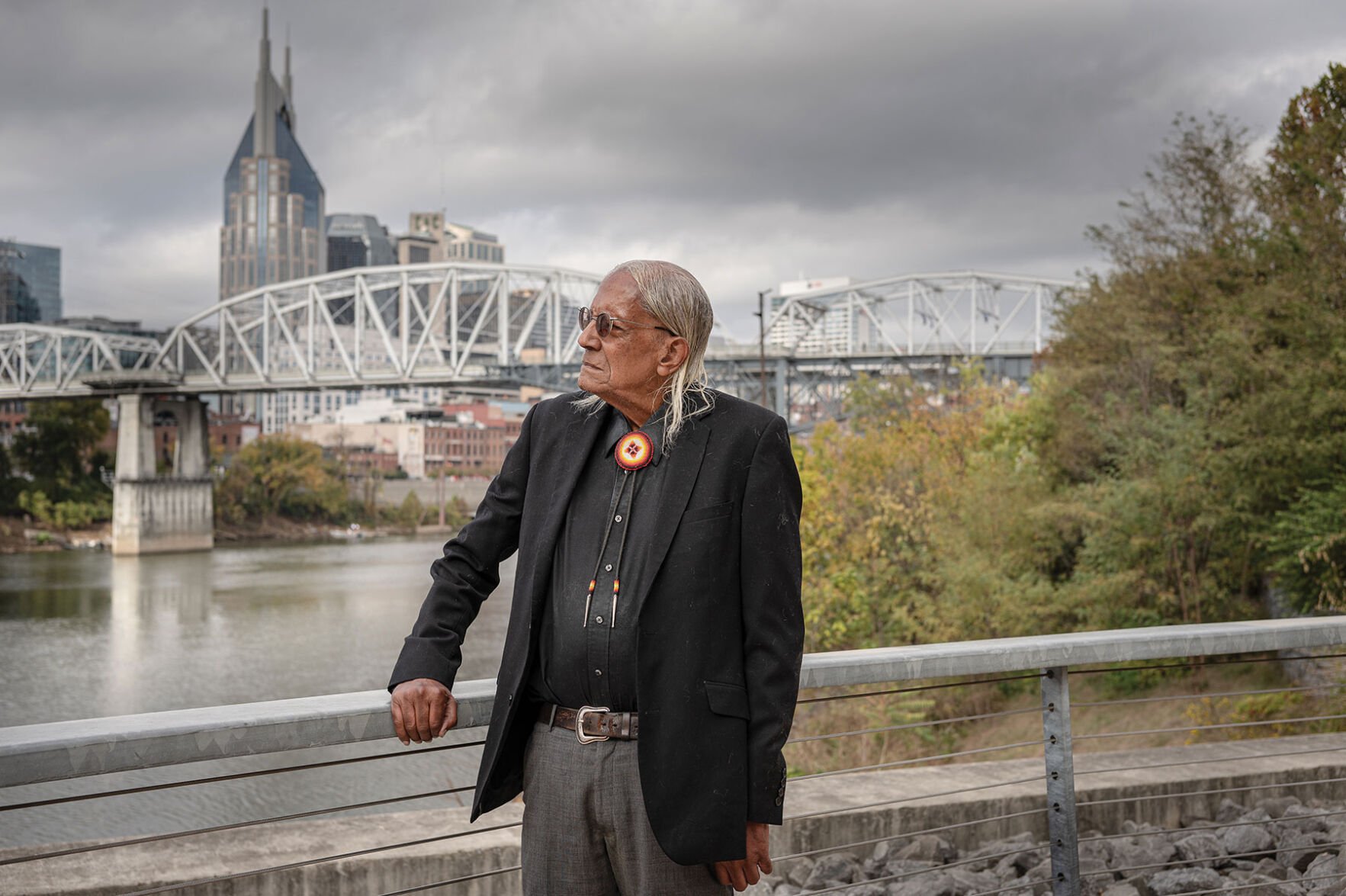Retired attorney Albert Bender is an author, historian, community activist, member of the Cherokee Nation and, in his words, “philosopher, if you will.” He’s even a one-time Scene contributor, having written a 2021 essay on the dark and damning legacy of President Andrew Jackson, whom Bender described as “a prime conductor on the murderous genocide train that roared from coast to coast.”
As the chair of Nashville’s Indigenous Peoples Coalition, Bender has recently been advocating for the renaming of Cumberland Park, the public green space that stretches along the bend of the Cumberland River near Nissan Stadium. With the coming of a new Tennessee Titans stadium and the associated development of hundreds of acres along the East Bank, lots of eyes are on the area — and alongside that attention, Bender and his colleagues hope to give the park a new name.
“Wasioto” is a Shawnee word that, according to some sources, means “mountains where the deer are plentiful.” It’s also the name the Shawnee people gave to the Cumberland River many generations before white people arrived in what is now known as Tennessee. Since August, Bender and the IPC have been engaging with the Metro Board of Parks and Recreation in an effort to rename the space Wasioto Park. At a Nov. 5 meeting of the Parks and Recreation Board, Bender and several of his fellow advocates expressed frustration that the process to rename the park has stretched on as long as it has, urging the board to move the final meeting in the process to rename the park — currently set for Tuesday, Dec. 3 — up to November, which is Native American Heritage Month.
Jackie Jones, community affairs superintendent of the Parks and Recreation Board, tells the Scene that while there are no plans to move the Dec. 3 meeting forward to November, that will indeed be the “final step in the process toward renaming Cumberland Park.” Bender and the IPC have continued to ask the board to reconsider, and as of press time, the group is planning a press conference and protest action in the coming days.
On a recent weekday morning, Bender joined the Scene at Cumberland Park to discuss his efforts to change the park’s name and Wasioto’s meaning to the local Indigenous community. Our conversation has been edited for length and clarity.
Tell me a little bit about the history of the park, and the proposed name change to Wasioto Park.
Cumberland Park comes from the name of the Cumberland River, and the Cumberland River was given that name by a European explorer, Thomas Walker, in 1758. Prior to that, or even during that time, there were numerous Shawnee villages all up and down this part of the Cumberland River in the vicinity of Nashville. In fact, there were so many Shawnee villages that this part of the river was referred to as the River of the Shawnees. But the ancient Shawnee name for the river is Wasioto. And even after Thomas Walker gave the name of Cumberland to the river, the river was for years and years after that still referred to as the River of the Shawnees.
Were the Shawnee very prevalent in Middle Tennessee and Kentucky?
I would say that they were the most prevalent in the 1670s to the 1680s. … And the Shawnees, of course, inhabited parts of Kentucky and also Ohio. But throughout the history of the Shawnee people, they moved around a lot, and history records that at different times, they lived in 23 different states.
Regarding the public input process, was there a lot of feedback?
It was overwhelmingly positive in favor of the name change. There was not one person who expressed an opinion that was in opposition to the name change. … It was very diverse. People showed up, of course, from the Indigenous community, and people from the African American community, and there were a number of white people who showed up and also spoke in favor of the name change. So far as I know, there is no credible opposition.
Why are name-change efforts like this one so important? Why is it something that you feel called to personally?
Well, one [reason] we feel that it is so significant and so important is because throughout the history of this country, there has been the process of genocide against Indigenous people — ethnic cleansing, if you will, of Indigenous people. Ethnic cleansing of the history of Indigenous people from the history books in the educational system. We feel that by having the park renamed, this is part of the start of a significant milestone in the history of Nashville for the further recognition and preservation of Indigenous history, both ancient and contemporary in the Middle Tennessee area.

Albert Bender in Cumberland Park
And do you think seeing Indigenous words and names puts that front-of-mind for people? Knowing that we’re on land that white settlers didn’t come to until just two or three centuries ago?
Yes, I think it does very much so, and it helps people to realize that we are the first people in this land. And it also helps people to realize, when they look into the history of this land [and see] numerous cities and public spaces that are named after European explorers and the like, they can see that this is something that happened unjustly, unfairly. This is still, when you look at it from the standpoint of the land being illegally taken, this is still our land, and we want to assert that.
Also it’s part of a nationwide campaign on the part of Indigenous people to have public spaces, rivers and other public areas given their original Indigenous names. Because when we talk about Cumberland Park being named Wasioto Park, we’re not talking about just the change of name. We’re talking about the name being changed to its original designation, and the original designation of the Cumberland River was Wasioto River. … There have been numerous instances of name changes of public spaces, and public areas being given Indigenous names all throughout the country, particularly west of the Mississippi.
Obviously the East Bank is going to be transformed over the next few years. Do you see it as being important for the Indigenous community and for Nashville at large for conversations about Indigenous spaces to be a part of the growth?
Yes, very much so, because the East Bank, to us as Indigenous people, is a sacred area. The East Bank encompasses what was, 1,000 years ago, a huge, huge Indigenous, Native American city that Nashville sits on top of. All of downtown Nashville sits on top of an ancient Indigenous city that covered not just all of downtown Nashville, but extended to the East Bank, into significant parts of East Nashville, with a population of over 400,000. When I first stumbled upon this fact, I was just astounded.
I mean, 400,000 is more than half the size of the city today.
Yeah. And in fact, the population of what’s called Metropolitan Nashville did not eclipse the population of ancient Nashville until at least the 1960s. And during that time — the year, I would say, 1300 — the area that now is covered by modern-day Nashville had a population of 400,000 within the immediate area, but counting the surrounding areas of Middle Tennessee, it had a population of over 1 million Indigenous residents, making it the largest Indigenous population in all the Southeast.
The Native American Indian Association of Tennessee, who you have worked with, has long talked about founding a cultural center on land on Bell Road. Is that something that’s still in discussion?
That’s still in the works. The Native American Indian Association is spearheading the construction of an Indigenous cultural center, and has been for some years. And is still in a headlong pursuit of that particular goal.
What would that look like?
Well, it would be a gathering place for Indigenous people, not just throughout Middle Tennessee, but through all of Tennessee, and it would have an educational component, a social services component and a number of different divisions that would service Native American people throughout all of Tennessee.
What else would you like to share about the meaning of changing this park’s name to Wasioto?
I mentioned how Native American people throughout the country were requesting and achieving the renaming of different public areas to original Indigenous names. A perfect example of that is the renaming of Clingmans Dome, which is the highest mountain in the Great Smoky Mountains National Park, which only a month or so ago was renamed, given its original name, its Cherokee name of Kuwohi, which means “mulberry place.” And this was at the request of the Eastern Band of Cherokee Indians, which we consider as being a great victory for the east-of-the-Mississippi campaign for the renaming of different public spaces and the like with their original Indigenous designation.
Photographing this year’s NAIA Pow Wow and discussing Nashville’s future with members of the Indigenous community






